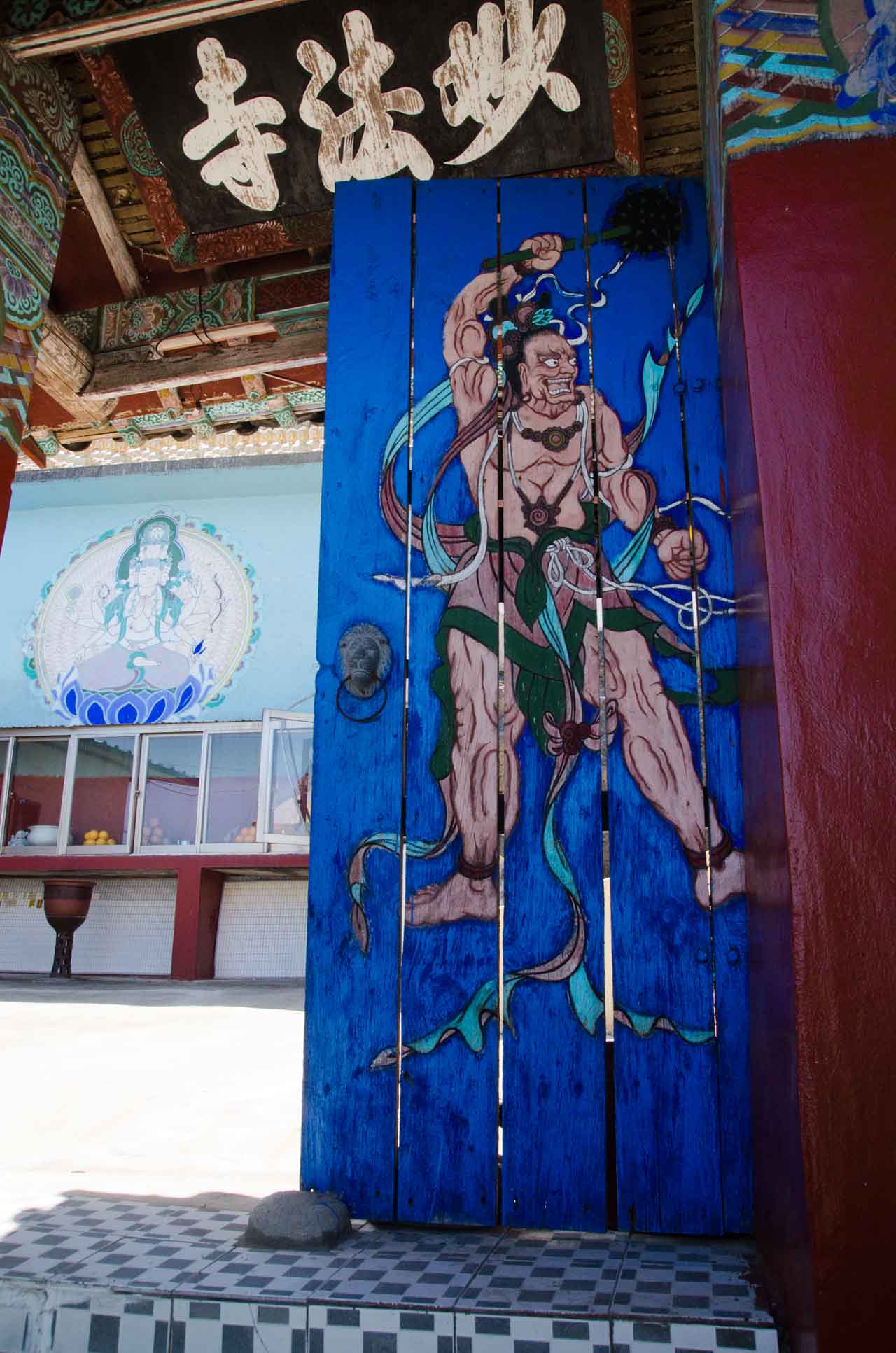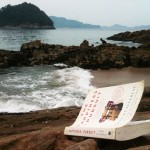
The Garden of Earthly Delights, right panel. Oil on oak panels. Hieronymus Bosch. Museo del Prado, Madrid. Circa 1500. Via Wikimedia.
See The Garden of Earthly Delights by Hieronymus Bosch

The Garden of Earthly Delights, right panel. Oil on oak panels. Hieronymus Bosch. Museo del Prado, Madrid. Circa 1500. Via Wikimedia.

 Dvarapala, Nampo, Busan, South Korea. May, 2017.
Dvarapala, Nampo, Busan, South Korea. May, 2017.


一
In Search of the Bull
In the pasture of the world,
I endlessly push aside the tall
grasses in search of the Ox.
Following unnamed rivers,
lost upon the interpenetrating
paths of distant mountains,
My strength failing and my vitality exhausted, I cannot find the Ox.

“Discovery of the Footprints” by Tenshō Shūbun. Via Wikimedia.
二
Discovery of the Footprints
Along the riverbank under the trees,
I discover footprints.
Even under the fragrant grass,
I see his prints.
Deep in remote mountains they are found.
These traces can no more be hidden
than one’s nose, looking heavenward.

“Perceiving the Bull” by Tenshō Shūbun. Via Wikimedia.
三
Perceiving the Bull
I hear the song of the nightingale.
The sun is warm, the wind is mild,
willows are green along the shore –
Here no Ox can hide!
What artist can draw that massive head,
those majestic horns?
四
Catching the Bull
I seize him with a terrific struggle.
His great will and power
are inexhaustible.
He charges to the high plateau
far above the cloud-mists,
Or in an impenetrable ravine he stands.
五
Taming the Bull
The whip and rope are necessary,
Else he might stray off down
some dusty road.
Being well-trained, he becomes
naturally gentle.
Then, unfettered, he obeys his master.
六
Riding the Bull Home
Mounting the Ox, slowly
I return homeward.
The voice of my flute intones
through the evening.
Measuring with hand-beats
the pulsating harmony,
I direct the endless rhythm.
Whoever hears this melody
will join me.

“The Bull Transcended” by Tenshō Shūbun. Via Wikimedia.
七
The Bull Transcended
Astride the Ox, I reach home.
I am serene. The Ox too can rest.
The dawn has come. In blissful repose,
Within my thatched dwelling
I have abandoned the whip and ropes.
八
Both Bull and Self Transcended
Whip, rope, person, and Ox –
all merge in No Thing.
This heaven is so vast,
no message can stain it.
How may a snowflake exist
in a raging fire.
Here are the footprints of
the Ancestors.
九
Too many steps have been taken
returning to the root and the source.
Better to have been blind and deaf
from the beginning!
Dwelling in one’s true abode,
unconcerned with and without –
The river flows tranquilly on
and the flowers are red.
Barefooted and naked of breast,
I mingle with the people of the world.
My clothes are ragged and dust-laden,
and I am ever blissful.
I use no magic to extend my life;
Now, before me, the dead trees
become alive.
—
Verses by Kuòān Shīyuǎn
Translation by Senzaki Nyogen (千崎如幻) (1876–1958) and Paul Reps (1895-1990).
Paintings by Tenshō Shūbun (天章周文) (1414-1463
From Ten Bulls Wikipedia article.
See:
http://www.buddhistdoor.com/OldWeb/passissue/9710/sources/art9.htm
http://www.columbia.edu/cu/weai/exeas/resources/oxherding.html
http://www.columbia.edu/cu/weai/exeas/syllabi.html


Baba Yaga as depicted by Ivan Bilibin (1902). Via Wikimedia.

The heroine Vasilisa outside of the hut of Baba Yaga as depicted by Ivan Bilibin (1902). Via Wikimedia.
See:


Photographic copy of a portrait lithograph made by Herman John Schmidt (1872-1959), from Auckland, of Vice-Admiral Robert Fitzroy (1805-1865), Governor of New Zealand 1843-1845. Via Wikimedia.

“He says that the ancients understood state craft better, when they figured The Prince as a centaur. The centaur is half man and half beast, and that’s what it is to understand state craft. Manly virtue will never be enough, you’ve got to be ready for beastliness, and the centaur is half beast. Now, that is presented directly as a satire of Cicero.”- Prof. Skinner
“Cicero had said, ‘Force is beastly and is to be avoided, that is simply the lion. Fraud is beastly and that is to be avoided, that is simply the fox’. And Machiavelli says, ‘Since you need to know how to be beastly, you had better know which particular beasts to imitate, and then in the most famous phrase in the book he says, ‘Those who have done best as princes in our time have known how to imitate the lion and the fox’.” – Prof. Skinner
‘You’re going to have to cheat, you must do your best to appear not to be cheating’, and that again is satirical in respect of Cicero’s De Officiis, because one of the things which Cicero keeps telling us is, ‘Fraud will always be found out. So you cannot gain true glory by pretence’, I’m now quoting Cicero, ‘because your pretences will always find you out’ And that becomes a biblical thought too. ‘Be sure your sins will find you out’. Now, one of the most important things that Machiavelli wants to tell The Prince is not to worry about that, because it’s not true. And he’s very keen on the fact that The Prince is not performing his politics in republican conditions. In republican conditions, you’re out in the piazza, everyone has a vote, it’s all public. People are watching you. You’ve only been elected, their turn will come, it’s a communal activity, everything is in the bright light of day. It’s not so for The Prince.” – Prof. Skinner
From Chapters 15-24 “‘Be courageously evil where it’s necessary to be evil, but otherwise follow what people regard as the virtues as much as possible. Because if you don’t, they’ll hate you, and if they hate you, you’re in trouble’. -Prof. Skinner

La muerte de Séneca. 1871. Manuel Domínguez Sánchez. Museo de Prado, Madrid. El título completo dado por el pintor fue: Séneca, después de abrirse las venas, se mete en un baño y sus amigos, poseídos de dolor, juran odio a Nerón que decretó la muerte de su maestro. Via Wikimedia.
“Machiavelli does himself say at one point in Chapter 15 – this pivotal and notorious chapter where he introduces the virtuoso prince who is not always virtuous. He says ‘I’m teaching you that sometimes you must learn, how not to be good’, and it’s interesting he doesn’t say there, virtuoso, he says buono, a good person. ‘Essarai non buono’ – how not to be a good person.”” – Prof. Skinner
“If you’re a prince, you need to go against conventional Christian or classical morality, if you’re an ordinary person, perhaps, you may want to carry on according to Christian or classical morality.” -Prof. Skinner

—
“sighting in the ascent, through a region of viscid gloom.
“He halted on the landing before the door and then, grasping the porcelain knob, opened the door quickly. He waited in fear, his soul pining within him, praying silently that death might not touch his brow as he passed over the threshold, that the fiends that inhabit darkness might not be given power over him. He waited still at the threshold as the entrance to some dark cave. Faces were there; eyes: they waited and watched.” p. 130
“He had sinned. He had sinned so deeply against heaven and before God that he was not worthy to be called God’s child.” p. 131
“His eyes were dimmed with tears and, looking humbly up to heaven, he wept for the innocence he had lost.” p. 133
“Once soul was lost; a tiny soul: his. It flickered once and went out, forgotten, lost. The end: black cold void waste.” p. 134
“and had first spoked of the kingdom of God to poor fishermen, teaching all men to be meek and humble of heart.” p. 135
“he called first to His side, the carpenters, the fishermen, poor and simple people following a lowly trade, handling and shaping the wood of trees, mending their nets with patience.” p. 135
“His blood began to murmur in his veins, murmuring like a sinful city summoned from its sleep to bear its doom. Little flakes of fire fell and powdery ashes fell softly, alighting on the houses of men. They stirred, waking from sleep, troubled by the heated air.” p. 136
“SUNDAY was dedicated to the mystery of the Holy Trinity, Monday to the Holy Ghost, Tuesday to the Guardian Angels, Wednesday to Saint Joseph, Thursday to the Most Blessed Sacrament of the Altar, Friday to the Suffering Jesus, Saturday to the Blessed Virgin Mary.” p. 141
“the three theological virtues, in faith in the Father Who had created him, in hope in the Son Who had redeemed him, and in love of the Holy Ghost Who had sanctified him;” p. 142
“Frequent and violent temptations were a proof that the citadel of the soul; had not fallen and that the devil raged to make it fall.” p. 147
“Some of the boys had then asked the priest if Victor Hugo were not the greatest French writer. The priest had answered that Victor Hugo had never written half so well when he had turned against the church as he had written when he was a catholic.” p. 150
“He had seen himself, a young and silentmannered priest, entering a confessional swiftly, ascending the altarsteps, incensing, genuflecting, accomplishing the vague acts of the priesthood which pleased him by reason of their semblance of reality and of their distance from it.” p. 152

Dieric Bouts,the older. At The Church of Saint Peter, Leuven, Belgium. Created: 1464 – 1467. Via Wikimedia.
“the order of Melchisedec.” p. 153
*****”He drew forth a phrase from his treasure and spoke it softly to himself:
-A day of dapled seaborne clouds.-
The phrase and the day and the scene harmonised in a chord. Words. Was it their colours? He allowed them to glow and fade, hue after hue: sunrise gold, the russet and green of apple orchards, azure of waves, the grey-fringed fleece of clouds. No, it was not their colours: it was the pose and balance of the period.” p. 160
askance
***”They were voyaging across the deserts of the sky, a host of nomads on the march, voyaging high over Ireland, westward bound. The Europe they had come from lay out there beyond the Irish Sea, Europe of strange tongues and valleyed and woodbegirt and citadelled and of entrenched and marshalled races.” p. 161

John Everett Millais – National Portrait Gallery. Via Wikimedia.
“His morning walk across the city had begun; and he foreknew that as he passed the sloblands of Fairview he would think of the cloistral silverveined prose of Newman; that as he walked along the North Strand Road, glancing idly at the windows of the provision ships, he would recall the dark humour of Guido Cavalcanti and smile; that as he went by Baird’s stone cutting works in Talbot Place the spirit of Ibsen would blow though him like a keen wind, a spirit of wayward boyish beauty;”p. 170
“His mind when wearied of its search for the essence of beauty amid the spectral words of Aristotle or Aquinas turned often for its pleasure to the dainty songs of the Elizabethans.” p. 170
“His thinking was a dusk of doubt and selfmistrust, lit up at moments by the lightnings of so clear a splendour that in those moments the world perished about his feet as if it had been fire consumed: and thereafter his tongue grew heavy and he met the eyes of others with unanswering eyes for he felt that the spirit of beauty had folded him round like a mantle and that in reveie at least he had been acquainted with nobility.” p. 171
“he had tried to peer into the social life of the city of cities through the words implere ollam denariorum which the rector had rendered sonorously as the filling of a pot with denaries.” p. 174
“but yet it wounded him to think that he would never be but a shy guest at the feast of the world’s culture and that the monkish learning, in terms of which he was striving to forge out an esthetic philosophy, was held no higher by the age he lived in than the subtle and curious jargons of heraldry and falconry.” p. 174
“the droll statue of the national poet of Ireland.” p. 174
“-Aquinas-answered Stephen-says pulcra sunt quæ visa placent.-” p. 180
“-In so far as it is apprehended by the sight, which I suppose means here esthetic intellection, it will be beautiful. But Aquinas also says Bonum est in quod tendit appetitus. In so far as it satisfies the animal craving for warmth fire is a good. In hell, however, it is an evil.-” p. 180

Nineteenth century Photochrom postcard of the Cliffs of Moher in County Clare in Ireland showing cliffside table and refreshments. Via Wikimedia.
“-These questions are very profound, Mr Dedalus-said the dean.-It is like looking down from the cliffs of Moher into the depth. Many go down into the depths and never come up. Only the trained diver can go down into those depths and explore them and come to the surface again.-” p. 181
“You know Epictetus?-
-An old gentleman-said Stephen coarsely-who said that the soul is very like a bucketful of water.-
-He tells us in his homely way-the dean went on-that he put an iron lamp before a statue of one of the gods and that a thief stole the lamp. What did the philosopher do? He reflected that it was in the character of a thief to steal and determined to buy and earthen lamp next day instead of the iron lamp.-” p. 181
“whether words are being used according to the literary tradition or according to the tradition of the marketplace. I remember a sentence of Newman’s, in which he says of the Blessed Virgin that she was detained in the full company of the saints. The use of the word in the marketplace is quite different. I hope I am not detaining you.-” p. 182
“That?-said Stephen.-Is that called a funnel? Is it not a tundish?-” p. 182
“-And to distinguish between the beautiful and the sublime-the dean added-to distinguish between moral beauty and material beauty. And to inquire what kind of beauty is proper to each of the various arts.” p. 184
“-In pursuing these speculations-said the dean conclusively-there is, however, the danger of perishing of inanition.” p. 184

The British Library – Image taken from page 274 of ‘Finland in the Nineteenth Century: by Finnish authors. Illustrated by Finnish artists. Via Wikimedia.
“-I may not have his talent-said Stephen quietly.
-You never know-said the dean brightly.-We never can say what is in us. I most certainly should not be despondent. Per aspera ad astra.-“


Dirck van Baburen – Prometheus Being Chained by Vulcan. circa 1594/1595–1624). Via Wikimedia.
Introduction by Stanley Wells
“The folio is, after all, a derivative, adapted, and edited text.” p. 8
“Muir, however, notes eclipses of both sun and moon in 1601 ‘that would still be remembered by the audience’, and there was a partial eclipse of the moon in May 1603.” p. 12
“Titus Andronicus he had already portrayed an elderly tyrant who goes mad” p. 14
“proposes that the opening scene is based on an ancient myth of a man’s having to choose among three women, the third one represents death. footnote p. 16
“written by the learned and imaginative monk Geoffrey of Monmouth” p. 17

Illumination of a 15th century manuscript of Historia Regum Britanniae showing king of the Britons Vortigern and Ambros watching the fight between two dragons. Via Wikimedia.
“Gonorilla to the Duke of Cornwall, Regan to the Duke of Albania, or Albany, the northern part of Britain. Later Aganipus, King of the Franks, married the dowerless Cordeilla for love.” p. 17

Cordelia. 1888. William Frederick Yeames (1835–1918). Via Wikimedia.

Edwin Austin Abbey (1852–1911) King Lear, Cordelia’s Farewell. Metropolitan Museum of Art – New York, NY . Via Wikimedia.
“Aganippus raised an army to restore him to his kingdom; they succeeded, and three years later Lear died. (By this time he must have been very old indeed.) Cordeilla, widowed, buried her father at Leicester. Some years later her nephews rebelled against her, captured her, and put her in prison, where she committed suicide.” p. 17
“In reading it, Shakespeare must have been struck by the relation between the Lear story and the episodes in Arcadia telling of a Paphlagonian king deposed and blinded by a wicked, illegitimate son but cherished by the natural son whom, under the influence of the bastard, he has cast off with orders-not obeyed-that he be killed.” p. 26
“Shakespeare is indebted to Arcadia for plot motifs and atmospheric effects rather than for language.” p. 26
“The Bible exerted a strong influence, even though Shakespeare has been at pains to locate his action in a non-Christian, pagan society; indeed, both the Book of Job and the parable of the Prodigal Son have been regarded as deep sources of the play.” p. 29
“It might on the contrary be argued that Shakespeare’s opening scene is a masterpiece of dramatic exposition-almost a little play in its own right-and that its reduction and simplification of motive is one of the ways in which it establishes a mode in which symbol and emblem will have as important a part to play as psychological verisimilitude.” p. 33
Michael Gambon playing the Fool “That weekend I hurried to London Zoo to watch the chimps and became even more convinced that they had all the requisite qualities for the Fool-manic comic energy when in action, a disturbing sadness when in repose.” p. 42
“But the suffering diminishes when madness comes upon him. As Gloucester is to realize later in the play, madness can bring relief from suffering.” p. 45
footnote Howard Felperin “takes a contrary view: Gloucester ‘naïvely wishes he could go made like Lear, mistaking madness for a protection against pain when it is in fact an exposure to it.” p. 45
“Suffering teaches both men how they have misvalued their offspring, and leads them to acknowledge their own faults and to express humility.” p. 46

José Ribera, Ixion (1632). Oil on canvas, 220 x 301 cm. Museo del Prado, Madrid. Via Wikimedia.
“The Wheel of Fire is part of the Aristotelian reading of a tragedy (e.g. plays), which includes the central flaw within a character.” wikipedia
“To its early audiences, the language of King Lear must have seemed very strange, as original in its day as that of James Joyce or Dylan Thomas in theirs.” p. 53
To read:
poems: Do not go gentle into that good night, and And death shall have no dominion.
Margreta de Grazia “the play itself goes to extremes, pushing beyond the bounds of tragedy, particularly in its superfluous addition of Cordelia’s death.” p. 53
“What Tate did to Shakespeare was not essentially different from what Shakespeare had done to King Leir: Shakespeare had turned an old tragicomedy into a tragedy, Tate reversed the process. In doing do created a new, different play which, critics have increasingly argued, has its own artistic validity.” p. 62
“But at the time Tate wrote, Shakespeare was not thought of as an immortal classic, but as a dramatist whose works, however admirable, required adaptation to fit them for the new theatrical and social circumstances of the time, as well as to changes in taste.” p. 62
Tate’s play “supplanted Shakespeare’s play in every performance given from 1681 to 1838.” p. 63
“Barker insists that the storm is not in itself ‘dramatically important, only in its effect upon Lear’, and that the actor should ‘impersonate both Lear and-reflected in Lear-the storm’.” p. 72
“The language of Shakespeare’s time was permeated by the Bible.” p. 87


Cervantes Saavedra, Miguel de. Don Quijote De La Mancha. Madrid: Real Academia Española, 2015. Print. (First ed. 1605)

Faulkner, William. The Sound and The Fury. New York: Vintage International, 1990. Print. (1984 correction, first ed. 1929)

Vallejos, Soledad. Trimarco: la mujer que lucha por todas las mujeres. Argentina: Aguilar, 2013. Print.

Guillebeau, Chris. The Happiness of Pursuit: Finding the Quest That Will Bring Purpose to Your Life. New York: Harmony Books, 2014. Print.

Miller, Arthur. Death of a Salesman. London, England: Penguin Classics, 2000. Print. [First ed. 1949.]

Covey, Stephen R. The 7 Habits of Highly Effective People: Restoring the Character Ethic. New York, N.Y.: Free Press, 2004. Print. (First ed. 1989).

Gilbert, Elizabeth. Eat, Pray, Love: One Woman’s Search for Everything Across Italy, India and Indonesia. New York, N.Y.; Penguin, 2007. Print. (First ed. 2006)

Haddon, Mark. the curious incident of the dog in the night-time. New York, NY: Vintage Books, 2004. Print. (First ed. 2003)

McCarthy, Cormac. The Orchard Keeper. New York, N.Y.: Vintage International, 1993. Print. (First ed. 1965).

Elam, Kimberly. Geometry of Design: Studies in Proportion and Composition. New York: Princeton Architectural, 2001. Print.

Graysmith, Robert. Zodiac: The Shocking True Story of The Nation’s Most Bizarre Mass Murderer. New York, NY: Berkley, 2007.

Pirsig, Robert M. Zen and the Art of Motorcycle Maintenance: An Inquiry into Values. New York: Harper Torch, 2006. Print.

Block, Bruce A. The Visual Story: Creating the Visual Structure of Film, TV and Digital Media. 2nd ed. Amsterdam: Focal/Elsevier, 2008. Print.

Hwang, Sŏn-mi, Chi-Young Kim, and Nomoco. The Hen Who Dreamed She Could Fly: A Novel. U.S.: Penguin Books, 2013. Print.

Turnbull, Stephen R., and Peter Dennis. Japanese Castles in Korea, 1592-98. Oxford: Osprey, 2007. Print.

Haruki Murakami. 村上 春樹 Norwegian Wood. (translated by Jay Rubin) 2011. Vintage Open-Market Edition. Published in Japanese in 1987.

Fisher, Roger, William Ury, and Bruce Patton. Getting to Yes: Negotiating Agreement without Giving in. New York: Penguin, 2011. Print.

Lowell, Ross. Matters of Light & Depth: Creating Memorable Images for Video, Film & Stills through Lighting. Philadelphia: Broad Street, 1992. Print.